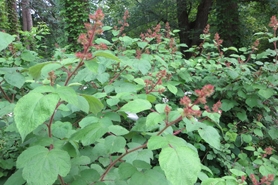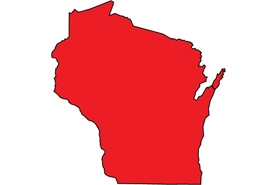Wineberry
(Rubus phoenicolasius)
Perennial shrub with arching stems up to 9’ in length. Purple-red hairs cover the entire plant (canes, petioles, sepals) and are interspersed with tiny prickles. Wineberry spreads vegetatively by rooting when canes touch the ground and form root buds.
Other names for this plant include:
- Common names: Japanese wineberry, wine raspberry
Classification in Wisconsin: Prohibited
- Ecological Threat
-
- Found along forest edges, fields, open woods and riparian areas such as streams and wetlands.
- Out-competes native vegetation by shading them out and rapid growth.
- Identification
-
Leaves: Alternate leaves are tri-lobed with leaflets being spade-heart shaped. Edges of leaves are serrated while the underside of leaves is white in appearance due to wooly white hairs.
Flowers: In spring, small, green flowers with white petals and tiny reddish hairs occur.
Fruits & seeds: The fruit is enclosed in a membrane until ripe, and the sepals open revealing the orange-red raspberry-type fruit.
Roots: Fibrous.
Similar species: Native blackberries and raspberries look very similar. The undersides of the leaves are generally green and sometimes a grayish-white color. Also, most do not have purplish-red hairs on the branches, petioles, or sepals. On the few with glandular hairs present, they are no longer than the thorns. Berries are black or red.
- Control
-
Mechanical: In small areas, plants can be hand-pulled or dug out. Mowing or cutting the stem followed by chemical treatment can also be effective.
Chemical: Foliar spray resprouts with triclopyr or metsulfuron-methyl; cut stump with glyphosate or triclopyr in the fall.
- Resources
- Sources for content:
- Sarver, M.J., A. Treher, L. Wilson, R. Naczi, and F.B. Kuehn, 2008. Mistaken Identity? Invasive Plants and their Native Look-alikes: an Identification Guide for the Mid-Atlantic. Dove, DE: Delaware Department of Agriculture and USDA Natural Resources Conservation Service. Pg 20-21.
- Swearingen, J., K. Reshetiloff, B. Slattery, and S. Zwicker. 2002. Plant Invaders of Mid-Atlantic Natural Areas [exit DNR]. National Park Service and U.S. Fish & Wildlife Service, 82 pp.


